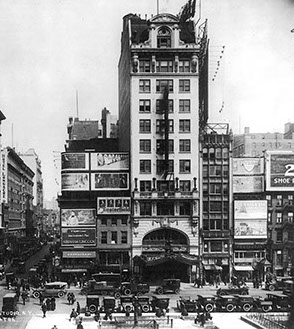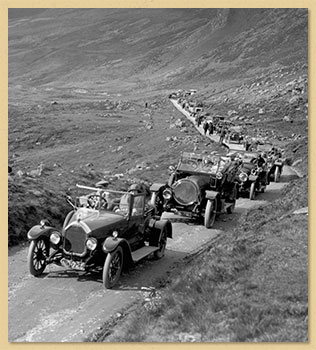


False Prosperity
PRESENTED BY: MATTHEW RUANE, PhD
MP3
Narrated by Scott Painton
NAVIGATION
Back to top
The Importance of Automobiles
Advertising
The Economy Under
Republican Leaders
Conclusion
Introduction

The Palace Theatre Building, New York City, 1920
The decade began with a recession as the government canceled thousands of military contracts and returning veterans swamped labor markets. Labor unions staged a huge number of strikes in 1919 in an attempt to secure wartime gains. Unemployment was at 2 percent when 1919 began, but by 1921, it had risen to more than 12 percent (Norton et al., 2012, p. 621). Recovery came in 1922 with a boom in consumer goods production – especially production of new electric goods. It was a new age of electricity, with more than 60 percent of the nation’s homes wired for electricity (p. 625). A mind-boggling array of new electrical appliances stood gleaming in stores – refrigerators, ranges, washing machines, vacuum cleaners, fans, razors, radios, mixers, and many more.
The Importance of Automobiles
Recovery also rested on the automobile and its related industries: rubber, gasoline and petroleum production, advertising, and highway construction. The introduction of installment credit, or payment over time, allowed consumer credit-based purchases to expand. Millions of automobiles, originally a cash-only business, were now purchased on installment credit – a process that continues to this day. A new Ford Model T cost $300 in 1924, which was the equivalent of three months’ wages for the average worker. To help meet growing consumer credit demand, the automobile industry took much of the financing in house. For example, the General Motors Acceptance Corporation (GMAC) was created to sell cars on installment credit. Failure to make a payment could result in the car being repossessed by the lender and resold, which limited any potential losses.
A car became a necessity rather than a luxury, and with the introduction of assembly-line techniques used to mass-produce automobiles, the number of registered cars increased from eight million in 1920 to 23 million by 1929 (p. 626). Federal financing of state roads was introduced by Congress in 1921, and the first timed, stop-and-go traffic light was introduced by General Electric in 1924 to control the increasing volume of traffic (p. 627).

1920s Motorists Driving Through the Countryside
Advertising
The Economy Under Republican Leaders
Elsewhere, organized labor was increasingly being linked to communism, and farmers suffered from the rise of agribusiness and the cost of mechanization. The rest of American business prospered under the Republican presidencies of Harding and Coolidge. Prosperity and mass production stimulated a wave of corporate mergers rivaling those of the turn of the century. By the end of the decade, over a thousand companies a year disappeared through mergers.
A few corporate giants came to dominate the major industries. Ford, General Motors, and Chrysler dominated automobile manufacturing. General Electric and Westinghouse were the leaders in electricity production and electrical goods manufacturing. United States Steel dominated steel production. United Fruit Company was the largest supplier of fruit and vegetables to consumers. Radio Corporation of America (RCA) was the leading manufacturer of radios.
Diversification occurred alongside many mergers. Companies began to branch out into different fields in an attempt to increase revenue and protect supply chains. Just as the federal government and many professional societies had been doing since the turn of the century, corporations bureaucratized their management in the ‘20s. They set up specialized divisions, each with its own team of managers, responsible for such varied spheres as product development, market research, economic forecasting, and employee relations. The day-to-day oversight of this new corporate structure increasingly fell to middle-class professionals trained in the techniques of management.
Government policies also helped business thrive in the 1920s. Tariffs were passed to limit imports and protect domestic industries from competition. Regulatory agencies such as the Federal Trade Commission (FTC) and the Interstate Commerce Commission (ICC) were often seen by businesses as tools to aid their business plans rather than as regulators. The Supreme Court also made several decisions to protect businesses from government regulation and weaken labor unions.
Conclusion
Prosperity for many Americans continued until 1929 with few interruptions. As American history has demonstrated again and again: for every upturn, there is an inevitable downturn. This time, in the fall of 1929, the downturn would plunge the United States nearly into the abyss.
References
Norton, M. B., Sheriff, C., Blight, D.W., Chudacoff, H. P., Logevall, F., & Bailey,
B. (2012). A people and a nation, volume II: Since 1865 (9th ed.). Boston, MA:
Wadsworth.

